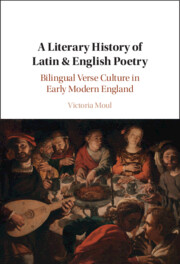Book contents
- A Literary History of Latin & English Poetry
- A Literary History of Latin & English Poetry
- Copyright page
- Dedication
- Contents
- Figures
- Acknowledgements
- Abbreviations
- Introduction
- Part I Shorter Verse
- Chapter 1 Anglo-Latin ‘Moralizing Lyric’ in Early Modern England
- Chapter 2 Metrical Variety and the Development of Latin Lyric Poetry in the Latter Sixteenth Century
- Chapter 3 Buchanan, Beza and the Genre of the Sidney Psalter
- Chapter 4 Formal Panegyric Lyric in England, 1550–1650
- Chapter 5 Abraham Cowley and Formal Innovation
- Chapter 6 Religious and Devotional Epigram and Lyric
- Chapter 7 Epigram Culture and Literary Bilingualism in Early Modern England
- Chapter 8 Satire, Invective and Humorous Verse
- Part II Longer Verse
- Afterword
- Metrical Appendix: Latin Metres
- Bibliography A: Manuscripts
- Bibliography B: Early Printed Books
- Bibliography C: Secondary Literature
- Index
Chapter 2 - Metrical Variety and the Development of Latin Lyric Poetry in the Latter Sixteenth Century
from Part I - Shorter Verse
Published online by Cambridge University Press: 23 June 2022
- A Literary History of Latin & English Poetry
- A Literary History of Latin & English Poetry
- Copyright page
- Dedication
- Contents
- Figures
- Acknowledgements
- Abbreviations
- Introduction
- Part I Shorter Verse
- Chapter 1 Anglo-Latin ‘Moralizing Lyric’ in Early Modern England
- Chapter 2 Metrical Variety and the Development of Latin Lyric Poetry in the Latter Sixteenth Century
- Chapter 3 Buchanan, Beza and the Genre of the Sidney Psalter
- Chapter 4 Formal Panegyric Lyric in England, 1550–1650
- Chapter 5 Abraham Cowley and Formal Innovation
- Chapter 6 Religious and Devotional Epigram and Lyric
- Chapter 7 Epigram Culture and Literary Bilingualism in Early Modern England
- Chapter 8 Satire, Invective and Humorous Verse
- Part II Longer Verse
- Afterword
- Metrical Appendix: Latin Metres
- Bibliography A: Manuscripts
- Bibliography B: Early Printed Books
- Bibliography C: Secondary Literature
- Index
Summary
The debate about prosody in English, focused in particular upon the decorum of rhyme and the role of quantitative metrics, is a well-known feature of late Elizabethan literary criticism. But the intense interest in metrical matters at this period sits within, and emerges from, a geographically wider and chronologically precedent Latin phenomenon which has not been described. Vernacular poets engaged deeply with metrical questions because the contemporary use of Latin metre underwent very rapid change in the second half of the sixteenth century.Although it has passed almost unnoticed by scholarship, metrical creativity is one of the most astonishing features of the Latin poetry of this period. We cannot begin to appreciate the literary excitement caused by this poetry – and by its vernacular imitations, such as the remarkable metrical display of the Sidney psalter and Herbert's "Temple" – without understanding something of the music of Latin metre, and of the pace of Latin metrical innovation. This chapter offers a ‘big picture’ overview of Latin metrical innovation and experiment, as it reached and was received and taught in England, in the latter half of the sixteenth century
Keywords
- Type
- Chapter
- Information
- A Literary History of Latin & English PoetryBilingual Verse Culture in Early Modern England, pp. 68 - 95Publisher: Cambridge University PressPrint publication year: 2022



